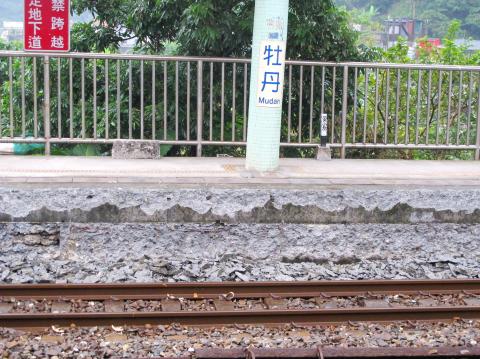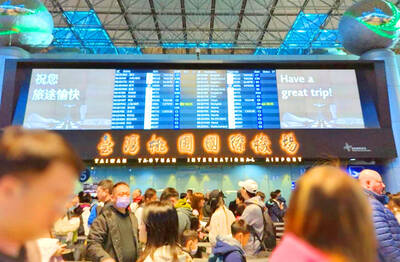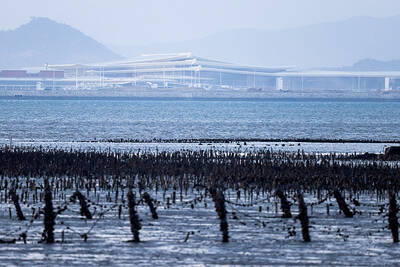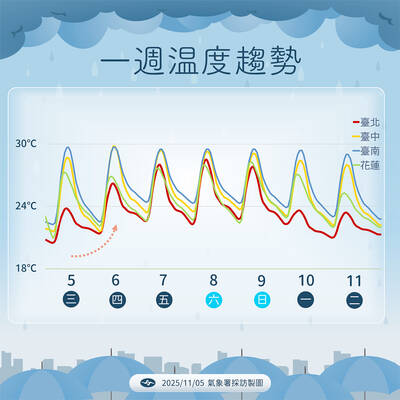With the Taiwan Railways Administration’s (TRA) new Puyuma trains entering the testing phase, the TRA has removed sections of train platforms at five stations, prompting questions about the design of the train.
The Puyuma is a tilted train that was purchased from Japan in 2010. The TRA has spent more than NT$10 billion (US$341 million) to purchase 136 cars, which are to be delivered between this year and 2014. If the train passes the trial run, it could start operating by Lunar New Year (February).
The first Puyuma train was transported to Taiwan on Oct. 25. On its first day on the tracks, it got caught between the platforms as it arrived at Keelung Station, scratching and denting the cars.

Photo: Yu Chao-fu, Taipei Times
An investigation revealed that the TRA’s maintenance branch had miscalculated the diameter of the track’s curve when laying down the tracks, causing the protective screen over the train’s controller panel to scrape along the edge of the Keelung station platform.
The TRA had to remove the edges of the platform to free the train, and the train was left with an 80cm scratch on the protective screen.
Four officials in the maintenance office were given demerits or transferred to another office.
The train started its test run at the beginning of the month on the west coast, and started its trial run on the east coast last week. However, doubts about the Puyuma’s design emerged again after media reports that multiple stations had to have their platforms altered to allow the Puyuma’s passage.
One TRA official, who wished to remain anonymous, said that the Puyuma was undoubtedly the “widest” train the TRA had run, adding that the train’s underside was unusually straight.
The Keelung platform incident occurred because the side skirts of the train was not indented enough, the official said, adding that even though other platforms the Puyuma had later passed through were higher and there had not been a repeat of the Keelung accident, there were also potential problems on the train’s top side.
An TRA official confirmed that due to the Puyuma’s test drive on the east coast rail, parts of the platforms at Nuannuan Township (暖暖), Mudan Township (牡丹), Gongliao District (貢寮), New Taipei City (新北市) and Heren Township (和仁) had been removed, while the Changhua station platform removed only the steps that were usually reserved for the station staff.
TRA mechanics division deputy chief Liu Tsan-huang (柳燦煌) said that there was no problem with the design of the train.
Liu said the width of a train may not exceed 3m, and when clear, the space from the center of the tracks to the platform edge must be 155.5cm, which means that even if the car of a train was 3m wide, there would be 5.5cm of space on either side.
Normal trains are between 280cm and 290cm wide, and the TRA had specified that the Puyuma should be 290cm wide, Liu said, adding that while it was the widest of all current cars, it was still within the margin of safety.
TRA maintenance division deputy chief Wen Tsai-yen (溫彩炎) also said that had the platform parts not been removed, the Puyuma would probably still have been able to pass.
Wen said that to err on the side of caution, the TRA was strictly maintaining a 310cm space when the tracks are clear, adding that the platforms in the smaller stations all had to be made higher before the end of the year in any case.
However, railway expert Hung Chih-wen (洪致文) said that the TRA’s original purpose in specifying a greater width for the Puyuma was to decrease the space between the train and the platform.
However, the TRA’s handling of the matter was contradictory and showed a lack of planning, Hung said.
Additional reporting by Yu Chao-fu and Tang Shih-ming

Three Taiwanese airlines have prohibited passengers from packing Bluetooth earbuds and their charger cases in checked luggage. EVA Air and Uni Air said that Bluetooth earbuds and charger cases are categorized as portable electronic devices, which should be switched off if they are placed in checked luggage based on international aviation safety regulations. They must not be in standby or sleep mode. However, as charging would continue when earbuds are placed in the charger cases, which would contravene international aviation regulations, their cases must be carried as hand luggage, they said. Tigerair Taiwan said that earbud charger cases are equipped

Foreign travelers entering Taiwan on a short layover via Taiwan Taoyuan International Airport are receiving NT$600 gift vouchers from yesterday, the Tourism Administration said, adding that it hopes the incentive would boost tourism consumption at the airport. The program, which allows travelers holding non-Taiwan passports who enter the country during a layover of up to 24 hours to claim a voucher, aims to promote attractions at the airport, the agency said in a statement on Friday. To participate, travelers must sign up on the campaign Web site, the agency said. They can then present their passport and boarding pass for their connecting international

UNILATERAL MOVES: Officials have raised concerns that Beijing could try to exert economic control over Kinmen in a key development plan next year The Civil Aviation Administration (CAA) yesterday said that China has so far failed to provide any information about a new airport expected to open next year that is less than 10km from a Taiwanese airport, raising flight safety concerns. Xiamen Xiangan International Airport is only about 3km at its closest point from the islands in Kinmen County — the scene of on-off fighting during the Cold War — and construction work can be seen and heard clearly from the Taiwan side. In a written statement sent to Reuters, the CAA said that airports close to each other need detailed advanced

UNKNOWN TRAJECTORY: The storm could move in four possible directions, with the fourth option considered the most threatening to Taiwan, meteorologist Lin De-en said A soon-to-be-formed tropical storm east of the Philippines could begin affecting Taiwan on Wednesday next week, the Central Weather Administration (CWA) said yesterday. The storm, to be named Fung-wong (鳳凰), is forecast to approach Taiwan on Tuesday next week and could begin affecting the weather in Taiwan on Wednesday, CWA forecaster Huang En-hung (黃恩鴻) said, adding that its impact might be amplified by the combined effect with the northeast monsoon. As of 2pm yesterday, the system’s center was 2,800km southeast of Oluanbi (鵝鑾鼻). It was moving northwest at 18kph. Meteorologist Lin De-en (林得恩) on Facebook yesterday wrote that the would-be storm is surrounded by